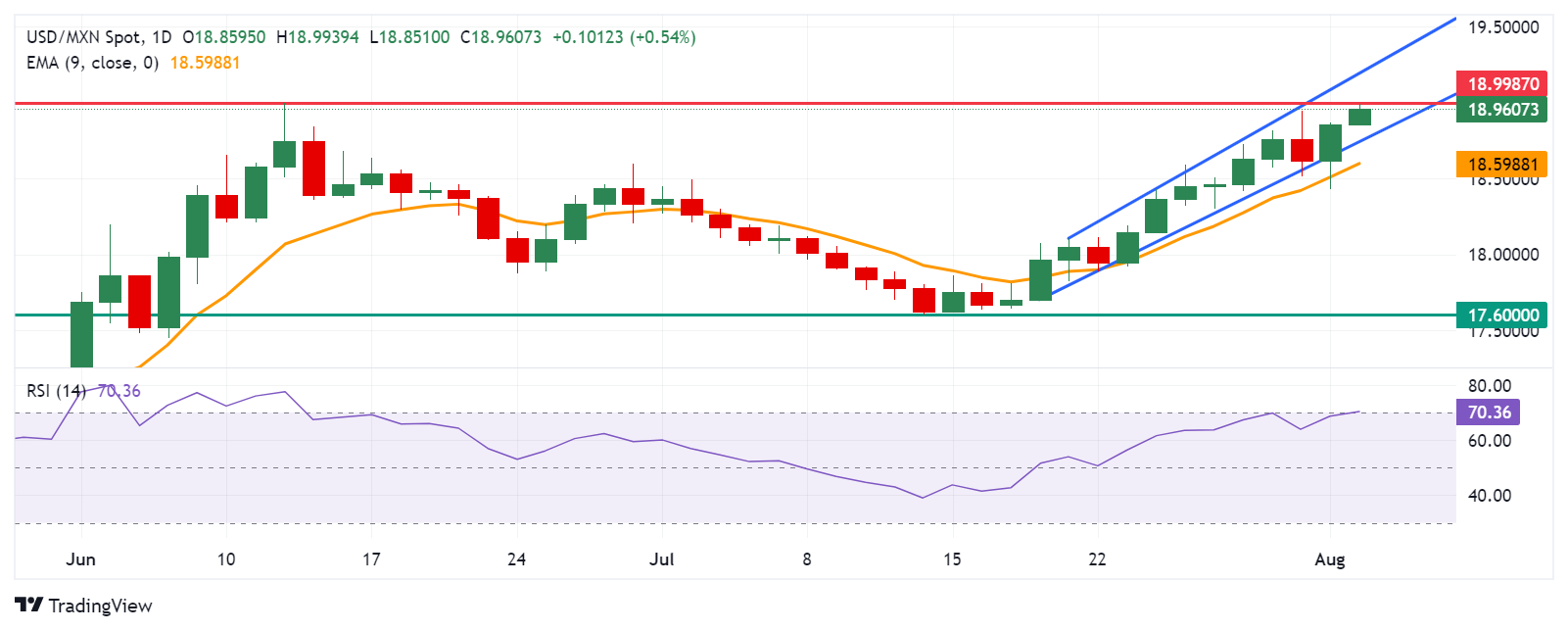- USD/MXN may depreciate as the momentum indicator 14-day RSI indicates a potential correction.
- A four-month high of 18.99 acts as an immediate resistance level.
- The pair could find support at the lower boundary of the ascending channel around the 18.70 level.
USD/MXN extends its gains for the second session, trading around 18.90 during the European hours on Friday. The analysis of the daily chart indicates the bullish bias as the pair is moving higher within an ascending channel.
However, the 14-day Relative Strength Index (RSI), a momentum indicator, is positioned at the 70 level, indicating that the USD/MXN pair is overbought. This suggests that a correction could be imminent.
On the upside, the USD/MXN pair tests a four-month high of 18.99 recorded on June 12. A breakthrough above this level could reinforce the bullish bias to test the upper boundary of the ascending channel near the level of 19.20.
In terms of support, the lower boundary of the ascending channel around the level of 18.70 could act as immediate support. Next support appears at the nine-day Exponential Moving Average (EMA) at 18.59. A break below this level could weaken the bullish sentiment and lead the USD/MXN pair to navigate the area around throwback support at the level of 17.60.
USD/MXN: Daily Chart
Mexican Peso FAQs
The Mexican Peso (MXN) is the most traded currency among its Latin American peers. Its value is broadly determined by the performance of the Mexican economy, the country’s central bank’s policy, the amount of foreign investment in the country and even the levels of remittances sent by Mexicans who live abroad, particularly in the United States. Geopolitical trends can also move MXN: for example, the process of nearshoring – or the decision by some firms to relocate manufacturing capacity and supply chains closer to their home countries – is also seen as a catalyst for the Mexican currency as the country is considered a key manufacturing hub in the American continent. Another catalyst for MXN is Oil prices as Mexico is a key exporter of the commodity.
The main objective of Mexico’s central bank, also known as Banxico, is to maintain inflation at low and stable levels (at or close to its target of 3%, the midpoint in a tolerance band of between 2% and 4%). To this end, the bank sets an appropriate level of interest rates. When inflation is too high, Banxico will attempt to tame it by raising interest rates, making it more expensive for households and businesses to borrow money, thus cooling demand and the overall economy. Higher interest rates are generally positive for the Mexican Peso (MXN) as they lead to higher yields, making the country a more attractive place for investors. On the contrary, lower interest rates tend to weaken MXN.
Macroeconomic data releases are key to assess the state of the economy and can have an impact on the Mexican Peso (MXN) valuation. A strong Mexican economy, based on high economic growth, low unemployment and high confidence is good for MXN. Not only does it attract more foreign investment but it may encourage the Bank of Mexico (Banxico) to increase interest rates, particularly if this strength comes together with elevated inflation. However, if economic data is weak, MXN is likely to depreciate.
As an emerging-market currency, the Mexican Peso (MXN) tends to strive during risk-on periods, or when investors perceive that broader market risks are low and thus are eager to engage with investments that carry a higher risk. Conversely, MXN tends to weaken at times of market turbulence or economic uncertainty as investors tend to sell higher-risk assets and flee to the more-stable safe havens.
Information on these pages contains forward-looking statements that involve risks and uncertainties. Markets and instruments profiled on this page are for informational purposes only and should not in any way come across as a recommendation to buy or sell in these assets. You should do your own thorough research before making any investment decisions. FXStreet does not in any way guarantee that this information is free from mistakes, errors, or material misstatements. It also does not guarantee that this information is of a timely nature. Investing in Open Markets involves a great deal of risk, including the loss of all or a portion of your investment, as well as emotional distress. All risks, losses and costs associated with investing, including total loss of principal, are your responsibility. The views and opinions expressed in this article are those of the authors and do not necessarily reflect the official policy or position of FXStreet nor its advertisers. The author will not be held responsible for information that is found at the end of links posted on this page.
If not otherwise explicitly mentioned in the body of the article, at the time of writing, the author has no position in any stock mentioned in this article and no business relationship with any company mentioned. The author has not received compensation for writing this article, other than from FXStreet.
FXStreet and the author do not provide personalized recommendations. The author makes no representations as to the accuracy, completeness, or suitability of this information. FXStreet and the author will not be liable for any errors, omissions or any losses, injuries or damages arising from this information and its display or use. Errors and omissions excepted.
The author and FXStreet are not registered investment advisors and nothing in this article is intended to be investment advice.
Recommended content
Editors’ Picks
EUR/USD falls sub-1.1000 after encouraging US data

EUR/USD slid towards the 1.0950 region following the release of upbeat United States macroeconomic data. The US Dollar surged after Retail Sales more than doubled expectations, while stocks also rallied amid optimism about the country's economic health.
GBP/USD nears 1.2800 after UK and US data

GBP/USD approaches 1.2800 in the early American session on Thursday. The UK data showed that the GDP expanded at an annual rate of 0.9% in Q2, as expected, underpinning the Pound. Encouraging US data, however, takes its toll on the pair.
Gold price battles plummets below $2,450 amid resurgent risk appetite

Gold price got hit by better-than-anticipated US data, and XAU/USD retreats sharply from an early peak at $2,469.80. Growing bets the Federal Reserve will trim interest rates and encouraging US data push investors away from the safe-haven metal.
AAVE price eyes for rally after retest of support level

Aave (AAVE) price trades slightly higher during the Asian trading session on Thursday after surging on Wednesday. On-chain data shows that open interest, daily active addresses and development activity are rising, signaling a bullish trend.
Fed rate cut in September? The data will decide

The US economy is currently navigating a period of slowing growth, persistent inflation, and a tight labour market. The Fed's aggressive monetary policy tightening over the past year has started to show results in moderating inflation
